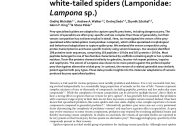Obsah
Prey-specialised spiders are adapted to capture specific prey items, including dangerous prey. The venoms of specialists are often prey-specific and less complex than those of generalists, but their venom composition has not been studied in detail. Here, we investigated the venom of the prey-specialised white-tailed spiders (Lamponidae: Lampona), which utilise specialised morphological and behavioural adaptations to capture spider prey. We analysed the venom composition using proteo-transcriptomics and taxon-specific toxicity using venom bioassays. Our analysis identified 208 putative toxin sequences, comprising 103 peptides <
10 kDa and 105 proteins >
10 kDa. Most peptides belonged to one of two families characterised by scaffolds containing eight or ten cysteine residues. Toxin-like proteins showed similarity to galectins, leucine-rich repeat proteins, trypsins and neprilysins. The venom of Lampona was shown to be more potent against the preferred spider prey than against alternative cricket prey. In contrast, the venom of a related generalist was similarly potent against both prey types. These data provide insights into the molecular adaptations of venoms produced by prey-specialised spiders.



